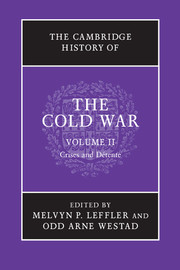Book contents
- Frontmatter
- 1 Grand strategies in the Cold War
- 2 Identity and the Cold War
- 3 Economic aspects of the Cold War, 1962–1975
- 4 The Cuban missile crisis
- 5 Nuclear competition in an era of stalemate, 1963–1975
- 6 US foreign policy from Kennedy to Johnson
- 7 Soviet foreign policy, 1962–1975
- 8 France, “Gaullism,” and the Cold War
- 9 European integration and the Cold War
- 10 Détente in Europe, 1962–1975
- 11 Eastern Europe: Stalinism to Solidarity
- 12 The Cold War and the transformation of the Mediterranean, 1960–1975
- 13 The Cold War in the Third World, 1963–1975
- 14 The Indochina wars and the Cold War, 1945–1975
- 15 The Cold War in the Middle East: Suez crisis to Camp David Accords
- 16 Cuba and the Cold War, 1959–1980
- 17 The Sino-Soviet split
- 18 Détente in the Nixon–Ford years, 1969–1976
- 19 Nuclear proliferation and non-proliferation during the Cold War
- 20 Intelligence in the Cold War
- 21 Reading, viewing, and tuning in to the Cold War
- 22 Counter-cultures: the rebellions against the Cold War order, 1965–1975
- 23 The structure of great power politics, 1963–1975
- 24 The Cold War and the social and economic history of the twentieth century
- Bibliographical essay
- Index
- References
6 - US foreign policy from Kennedy to Johnson
Published online by Cambridge University Press: 28 September 2010
- Frontmatter
- 1 Grand strategies in the Cold War
- 2 Identity and the Cold War
- 3 Economic aspects of the Cold War, 1962–1975
- 4 The Cuban missile crisis
- 5 Nuclear competition in an era of stalemate, 1963–1975
- 6 US foreign policy from Kennedy to Johnson
- 7 Soviet foreign policy, 1962–1975
- 8 France, “Gaullism,” and the Cold War
- 9 European integration and the Cold War
- 10 Détente in Europe, 1962–1975
- 11 Eastern Europe: Stalinism to Solidarity
- 12 The Cold War and the transformation of the Mediterranean, 1960–1975
- 13 The Cold War in the Third World, 1963–1975
- 14 The Indochina wars and the Cold War, 1945–1975
- 15 The Cold War in the Middle East: Suez crisis to Camp David Accords
- 16 Cuba and the Cold War, 1959–1980
- 17 The Sino-Soviet split
- 18 Détente in the Nixon–Ford years, 1969–1976
- 19 Nuclear proliferation and non-proliferation during the Cold War
- 20 Intelligence in the Cold War
- 21 Reading, viewing, and tuning in to the Cold War
- 22 Counter-cultures: the rebellions against the Cold War order, 1965–1975
- 23 The structure of great power politics, 1963–1975
- 24 The Cold War and the social and economic history of the twentieth century
- Bibliographical essay
- Index
- References
Summary
Like their predecessor Dwight D. Eisenhower, Presidents John F. Kennedy and Lyndon B. Johnson adhered to the major tenets of post-World War II US foreign policy. They saw the Cold War as a long-term struggle played out in military, ideological, political, economic, scientific, and cultural arenas. All three leaders sought to contain the Soviet Union while advancing US influence around the globe. They agreed that radical revolution threatened US interests, and that such upheavals were instigated by the Soviets, “Red China,” or Fidel Castro’s Cuba. All three presidents believed that Western-style modernization – and particularly American values and institutions – offered the best model for developing nations. They also concurred on the strategy of tightening links with European allies in order to win the Cold War, head off potential problems with Germany, and compensate for the relative decline in US economic predominance. Kennedy (JFK) and Johnson (LBJ) differed from Eisenhower, however, in embracing an exuberant activism that “Ike” distrusted. In their respective presidencies, Kennedy and Johnson saw greater opportunities and threats than Eisenhower perceived in his time. While Kennedy and Johnson differed in background, style, and the relative emphasis each placed on domestic or foreign initiatives, they shared similar ideological assumptions and policy goals. Both had competitive personalities.
- Type
- Chapter
- Information
- The Cambridge History of the Cold War , pp. 112 - 133Publisher: Cambridge University PressPrint publication year: 2010
References
- 6
- Cited by



